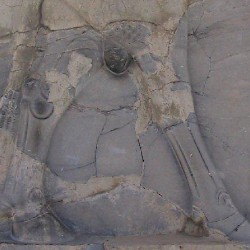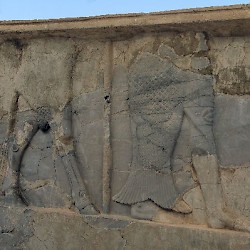Pasargadae, Palace S
Pasargadae: one of the oldest residences of the Achaemenid kings, founded by Cyrus the Great (r.559-530). It resembled a park of 2x3 km in which several monumental buildings were to be seen.

The excavators of Pasargadae identified Palace S as a reception hall, because it was halfway the gate and the residential Palace P. The white column they reerected, the oldest known stone pillar in Iran, is more than 13 meters high, which gives an indication of the monumental size of this building, which was designed to impress visitors. The black capitals of the columns must have resembled bulls, griffins, lions, and horses. The first three of these types are also known from Persepolis.

The audience hall itself measured 32¼ x 22¼ meters, which means that it was an oblong structure, just like residential Palace P and the buildings at Godin Tepe and Tepe Nush-e Jan, but unlike the palaces of Persepolis. The two structures on the second picture are corners of this hall.
Like residential Palace P, Palace S boasts an inscription in the Old Persian cuneiform script. Because this type of writing was designed in 521 BCE - it was used for the first time in the Behistun Inscription, which also states that this "Aryan script" was designed especially for the purpose - the inscriptions in the Palaces P and S cannot have been added prior to the reign of Darius I the Great. Probably, this king, an usurper, tried to show continuity with the founder of the Persian Empire by stressing that they both belonged to the same Achaemenid family.
The text of the inscription, usually called CMa, is:

adam \ kuruš \ xšâya-
thiya \ haxâmanišiyaI, Cyrus the king, an Achaemenid.

The second and third part of this inscription are in Elamite and Babylonian.
On both sides of the entrance of Palace S are damaged but very remarkable reliefs. To the left and right of the gate, we can see the feet of two figures. They are walking like human beings, but they are not human. As you can see on the photos below, one of these people has the tail of fish, another one has bull's legs, and there's also a person with bird's claws. Only the fourth one appears to have normal human feet.
The fish-man is also known from Babylonia and Assyria, and is probably identical to a mythological creature called "Ea" and "Oannes", who is mentioned by Berossus of Babylon. In his Babyloniaca, he tells how after the Creation, Oannes taught humankind all kinds of useful knowledge (text). He is one of the "seven sages" of the ancient Near East (apkallū). Small figurines of the fish-man were often used as protective talismans, but the relief in Palace S is unusually large.
 Pasargadae, Palace S, Relief of the bull-man |
 Pasargadae, Palace S, Relief of the bull- and the fish-man |
 Neo-Assyrian plaque of Oannes |
 Pasargadae, Palace S, Relief of the bird-man |
The bull-man is another Mesopotamian protective demon and may also have belonged to one of the stories told about the Creation. In Babylonia, he is usually presented as an attendant of the sun god Šamaš. The person with the bird's claws belongs to the scorpion people or girtablullû, who are otherwise known to have a human head and body, a scorpion's tale, and a snake-like penis. Scorpio-men are also known to have played a role in apotropaic magic. The human feet must belong to another, unidentifiable protective spirit.